Synchronous Sampling-Based Direct Current Estimation Method for Self-Sensing Active Magnetic Bearings
Abstract
:1. Introduction
2. Methodology
2.1. Research Framework
2.2. Amplitude Demodulation Algorithm
2.3. DCE-LSM Algorithm
2.4. SS-DCE Algorithm
3. Results and Discussion
3.1. Experimental Platform
3.2. Simulation Results
3.3. Experimental Results
4. Conclusions
Author Contributions
Funding
Acknowledgments
Conflicts of Interest
References
- Vischer, D. Sensorless and Voltage Driven Magnetic Bearing [D]; Swiss Federal Institute of Technology: Lausanne, Switzerland; Zurich, Switzerland, 1988. [Google Scholar]
- Cannon, R.H.; Rosenthal, D.E. Experiments in control of flexible structures with noncolocated sensors and actuators. J. Guid. 1984, 7, 546–553. [Google Scholar] [CrossRef]
- Karkoub, M.; Balas, G.J.; Tamma, K. Colocated and noncolocated control design via μ-synthesis for flexible manipulators. In Proceedings of the 1995 American Control Conference-ACC’95, Seattle, WA, USA, 21–23 June 1995; Volume 15, pp. 3321–3325. [Google Scholar] [CrossRef]
- Malsen, E.H.; Schweitzer, G. Magnetic bearings: Theory, design, and application to rotating machinery. In Self-Sensing Magnetic Bearings; Maslen, E.H., Ed.; Springer: Dordrecht, The Netherlands; Heidelberg, Germany; London, UK; New York, NY, USA, 2009; pp. 329–338. ISBN 978-3-642-00497-1. [Google Scholar] [CrossRef]
- Vischer, D.; Bleuler, H. Self-sensing active magnetic levitation. IEEE Trans. Magn. 1993, 29, 1276–1281. [Google Scholar] [CrossRef]
- Mizuno, T.; Bleuler, H.; Gähler, C.; Vischer, D. Towards practical applications of self-sensing magnetic bearings. In Proceedings of the 3rd International Symposium on Magnetic Bearings, Washington, DC, USA, 29–31 July 1992; pp. 169–175. [Google Scholar]
- Morse, N.; Smith, R.; Paden, B.; Antaki, J. Position Sensed and Self-Sensing Magnetic Bearing Configurations and Associated Robustness Limitations. In Proceedings of the IEEE Conference on Decision and Control Including the Symposium on Adaptive Processes, Tampa, FL, USA, 18 December 1998; Volume 3, pp. 2599–2604. [Google Scholar] [CrossRef]
- Maslen, E.H.; Montie, D.T.; Iwasaki, T. Robustness limitations and self-sensing magnetic bearings. J. Dyn. Syst. Meas. Control Trans. ASME 2006, 128, 197–203. [Google Scholar] [CrossRef]
- Park, Y.H.; Han, D.C.; Park, I.H. A self-sensing technology of active magnetic bearings using a phase modulation algorithm based on a high frequency voltage injection method. J. Mech. Sci. Technol. 2008, 22, 1757–1764. [Google Scholar] [CrossRef]
- Ge, Y.Q.; Wang, C.S.; Zhou, X.M.; Wang, H. Research on rotor position sensing of a permanent magnet synchronous motor based on high-frequency voltage injection and Kalman filter. In Proceedings of the 2010 International Conference on Electrical and Control Engineering (ICECE 2010), Wuhan, China, 25–27 June 2010; pp. 1750–1754. [Google Scholar] [CrossRef]
- Bugsch, M.; Piepenbreier, B. HF Test Current-Ripple-Control-Based Sensorless Method for SynRMs in the Low- and Zero-Speed Range Leading to an Adaptive Square-Wave-Shaped Voltage Injection. In Proceedings of the 2018 IEEE 9th International Symposium on Sensorless Control for Electrical Drives (SLED), Helsinki, Finland, 13–14 September 2018; pp. 24–29. [Google Scholar] [CrossRef]
- Tan, D.P.; Ji, S.M.; Jin, M.S. Intelligent computer-aided instruction modeling and a method to optimize study strategies for parallel robot instruction. IEEE Trans. Educ. 2013, 56, 268–273. [Google Scholar] [CrossRef]
- Okada, J.; Matsuda, K. Nagai, Sensorless magnetic levitation control by measuring the PWM carrier frequency component. In Proceedings of the 3rd International Symposium on Magnetic Bearings, Washington, DC, USA, 29–31 July 1992; pp. 176–183. [Google Scholar]
- Noh, M.D. Self-Sensing Magnetic Bearings Driven by a Switching Power Amplifier. Ph.D. Thesis, University of Virginia, Charlottesville, WV, USA, 1996. [Google Scholar]
- Mizuno, T.; Araki, K.; Bleuler, H. Stability analysis of self-sensing magnetic bearing controllers. IEEE Trans. Control Syst. Technol. 1996, 4, 572–579. [Google Scholar] [CrossRef]
- Schammass, A.; Herzog, R.; Buhler, P.; Bleuler, H. New results for self-sensing active magnetic bearings using modulation approach. IEEE Trans. Control Syst. Technol. 2005, 13, 509–516. [Google Scholar] [CrossRef]
- Lu, J.; Feng, K. Study on MSMA Self-Sensing Actuator Based on DSP. In Proceedings of the 2019 Chinese Automation Congress (CAC), Hangzhou, China, 22–24 November 2019; pp. 2866–2870. [Google Scholar] [CrossRef]
- Zhang, Z.L.; Du, Z.M.; Deng, L.; Zhou, C.; Cao, Z.Q.; Cheng, L. A Fusion Measurement Method Based on Kalman Filter with Improved State Block and Neural Network for Nanometer Displacement. In Proceedings of the 2018 IEEE International Conference on Mechatronics and Automation (ICMA), Changchun, China, 5–8 August 2018; pp. 539–544. [Google Scholar] [CrossRef]
- Zhang, L.; Yuan, Z.; Tan, D.; Huang, Y. An improved abrasive flow processing method for complex geometric surfaces of titanium alloy artificial joints. Appl. Sci. 2018, 28, 1037. [Google Scholar] [CrossRef] [Green Version]
- Pan, Y.; Ji, S.M.; Tan, D.P. Cavitation based soft abrasive flow processing method. Int. J. Adv. Manuf. Technol. 2019. [Google Scholar] [CrossRef]
- Tan, D.P.; Zhang, L.B.; Ai, Q.L. An embedded self-adapting network service framework for networked manufacturing system. J. Intell. Manuf. 2019, 30, 539–556. [Google Scholar] [CrossRef]
- Tan, D.P.; Li, L.; Yin, Z.C.; Li, D.F.; Zhu, Y.L.; Zheng, S. Ekman boundary layer mass transfer mechanism of free sink vortex. Int. J. Heat Mass Trans. 2020, 150, 119250. [Google Scholar] [CrossRef]
- Yu, J.; Zhu, C.S. Self-sensing active magnetic bearing using Hilbert transform. J. Zhejiang Univ. Eng. Sci. 2015, 49, 732–739. [Google Scholar] [CrossRef]
- Li, L.; Qi, H.; Yin, Z.C.; Li, D.F.; Zhu, Z.L.; Tangwarodomnukun, V.; Tan, D.P. Investigation on the multiphase sink vortex Ekman pumping effects by CFD-DEM coupling method. Powder Technol. 2020, 360, 462–480. [Google Scholar] [CrossRef]
- Li, C.; Ji, S.M.; Tan, D.P. Softness abrasive flow method oriented to tiny scale mold structural surface. Int. J. Adv. Manuf. Technol. 2012, 61, 975–987. [Google Scholar] [CrossRef]
- Li, C.; Ji, S.M.; Tan, D.P. Multiple-loop digital control method for 400Hz inverter system based on phase feedback. IEEE Trans. Power Electron. 2013, 28, 408–417. [Google Scholar] [CrossRef]
- Haarnoja, T.; Halmeaho, T.; Manninen, A.; Tammi, K. Position estimation method for self-sensing electric machines based on the direct measurement of the current slope. In Proceedings of the 7th IET International Conference on Power Electronics, Machines and Drives (PEMD 2014), Manchester, UK, 8–10 April 2014; p. 16. [Google Scholar] [CrossRef]
- Tian, Z.; Wei, Z.; Guo, B.; Sun, Y. A Rotor Displacement Estimation Method for Magnetic Bearings with Direct Measurement of the Ripple Current Slope. In Proceedings of the 2019 IEEE International Conference on Mechatronics and Automation (ICMA), Tianjin, China, 4–7 August 2019; pp. 1848–1853. [Google Scholar] [CrossRef]
- Zhang, L.B.; Lv, H.P.; Tan, D.P.; Xu, F.; Chen, J.L.; Bao, G.J.; Cai, S.B. An adaptive quantum genetic algorithm for task sequence planning of complex assembly systems. Electron. Lett. 2018, 54, 870–871. [Google Scholar] [CrossRef]
- Zhang, L.; Wang, J.S.; Tan, D.P.; Yuan, Z.M. Gas compensation-based abrasive flow processing method for complex titanium alloy surfaces. Int. J. Adv. Manuf. Technol. 2017, 92, 3385–3397. [Google Scholar] [CrossRef]
- Glück, T.; Kemmetmüller, W.; Tump, C.; Kugi, A. A novel robust position estimator for self-sensing magnetic levitation systems based on least squares identification. Control Eng. Pract. 2011, 19, 146–157. [Google Scholar] [CrossRef]
- Rizzello, G.; Naso, D.; York, A.; Seelecke, S. Self-sensing in dielectric electro-active polymer actuator using linear-in-parametes online estimation. In Proceedings of the 2015 IEEE International Conference on Mechatronics (ICM), Nagoya, Japan, 6–8 March 2015; pp. 300–306. [Google Scholar] [CrossRef]
- Rizzello, G.; Fugaro, F.; Naso, D.; Seelecke, S. Simultaneous Self-Sensing of Displacement and Force for Soft Dielectric Elastomer Actuators. IEEE Robot. Autom. Lett. 2018, 3, 1230–1236. [Google Scholar] [CrossRef]
- Li, L.; Lu, J.F.; Fang, H.; Yin, Z.C.; Wang, T.; Wang, R.H.; Fan, X.H.; Zhao, L.J.; Tan, D.P.; Wan, Y.H. Lattice Boltzmann method for fluid-thermal systems: Status, hotspots, trends and outlook. IEEE Access 2020, 8, 27649–27675. [Google Scholar] [CrossRef]
- Nevaranta, N.; Jaatinen, P.; Vujolainen, J.; Sillanpaa, T. Adaptive MIMO pole placement control for commissioning of a rotor system with active magnetic bearings. Mechatronics 2020, 65, 74–81. [Google Scholar] [CrossRef]
- Sun, Y.; Shen, Q.; Ye, H. Speed-sensorless control system of bearingless induction motor based on modified adaptive fading unscented kalman filter. Trans. Chin. Soc. Agric. Eng. 2018, 34, 74–81. [Google Scholar] [CrossRef]
- Yang, Z.; Wang, M.; Sun, X. Control system of bearingless induction motors based on adaptive neuro-fuzzy inference system. Trans. Chin. Soc. Agric. Eng. 2014, 30, 78–86. [Google Scholar] [CrossRef]
- Ge, J.Q.; Tan, D.P.; Ji, S.M. A gas-liquid-solid three-phase abrasive flow processing method based on bubble collapsing. Int. J. Adv. Manuf. Technol. 2018, 95, 1069–1085. [Google Scholar] [CrossRef]
- Sun, Z.; Zhao, J.J.; Shi, Z.G. Soft sensing of magnetic bearing system based on support vector regression and extended Kalman filter. Mechatronics 2014, 24, 186–197. [Google Scholar] [CrossRef]
- Matsuda, K.; Kijimoto, S.; Kanemitsu, Y. Self-Sensing Three-Pole Magnetic Bearing Using a Kalman Filter. In Proceedings of the 2006 SICE-ICASE International Joint Conference, Busan, Korea, 18–21 October 2006; pp. 1590–1594. [Google Scholar] [CrossRef]
- Ranft, E.O.; Van Schoor, G.; Du Rand, C.P. Self-sensing for electromagnetic actuators Part II: Position estimation. Sens. Actuator A Phys. 2011, 172, 410–419. [Google Scholar] [CrossRef]
- Van Schoor, G.; Niemann, A.C.; Du Rand, C.P. Evaluation of demodulation algorithms for robust self-sensing active magnetic bearings. Sens. Actuator A Phys. 2013, 189, 441–450. [Google Scholar] [CrossRef]
- Yu, J.; Zhu, C.S. A Multifrequency Disturbances Identification and Suppression Method for the Self-Sensing AMB Rotor System. IEEE Trans. Ind. Electron. 2018, 65, 6382–6392. [Google Scholar] [CrossRef]
- Li, J.; Ji, S.M.; Tan, D.P. Improved soft abrasive flow finishing method based on turbulent kinetic energy enhancing. Chin. J. Mech. Eng. 2017, 30, 301–309. [Google Scholar] [CrossRef]
- Hu, X.; Xu, F.; Tan, D. A synchronous sampling-based direct current estimation method for self-sensing active magnetic bearings. J. Zhejiang Univ. Sci. A 2020, 41, 401–405. [Google Scholar] [CrossRef]
- Niemann, A.C.; Van Schoor, G.; Du Rand, C.P. A Self-sensing active magnetic bearing based on a direct current measurement approach. Sensors 2013, 13, 12149–12165. [Google Scholar] [CrossRef] [PubMed] [Green Version]
- Yu, J.; Zhu, C.S. Position estimation accuracy improvement based on accurate modeling of self-sensing active magnetic bearings. Sens. Actuator A Phys. 2016, 248, 233–245. [Google Scholar] [CrossRef]
- Ji, S.M.; Ge, J.Q.; Tan, D.P. Wall contact effects of particle-wall collision process in two-phase particle fluid. J. Zhejiang Univ. Sci. A 2017, 18, 958–973. [Google Scholar] [CrossRef]
- Tan, D.P.; Chen, S.T.; Bao, G.J.; Zhang, L.B. An embedded lightweight GUI component library and the ergonomics optimization method for industry process monitoring. Front. Inform. Technol. Electron. Eng. 2018, 19, 604–625. [Google Scholar] [CrossRef]
- Tang, M.; Zhu, C.; Yu, J. Cooperative rotor position estimation of active magnetic bearings with unsaturated magnetic bias. Trans. China Electrotech. Soc. 2014, 29, 205–212. [Google Scholar] [CrossRef]
- Jiang, Y.; Wang, K.; Sun, M.; Xie, J. Displacement self-Sensing method for AMB-rotor systems using current ripple demodulations combined with PWM command signals. IEEE Sens. J. 2019, 19, 5460–5469. [Google Scholar] [CrossRef]
- Yu, J.; Zhu, C.; Yu, Z. Rotor position estimation strategy for self-sensing active magnetic bearing considering eddy currents. Trans. China Electrotech. Soc. 2018, 33, 1946–1956. [Google Scholar] [CrossRef]
- Ji, S.M.; Xiao, F.Q.; Tan, D.P. Analytical method for softness abrasive flow field based on discrete phase model. Sci. China Technol. Sci. 2010, 53, 2867–2877. [Google Scholar] [CrossRef]
- Wang, Y.; Ni, P.; Wen, D.; Lin, Q.; Wang, D.; Ma, C.; Rao, Y.; Wang, H.; Tan, D. Dynamic performance optimization of circular sawing machine gearbox. Appl. Sci. 2019, 9, 4458. [Google Scholar] [CrossRef] [Green Version]
- Cao, G.Z.; Pan, J.F.; Huang, S.D.; Qiu, H. Control Algorithms and Their Realization in the Magnetic Levitation System; Tsinghua University Press: Beijing, China, 2013; p. 80. ISBN 9787302308966. [Google Scholar]





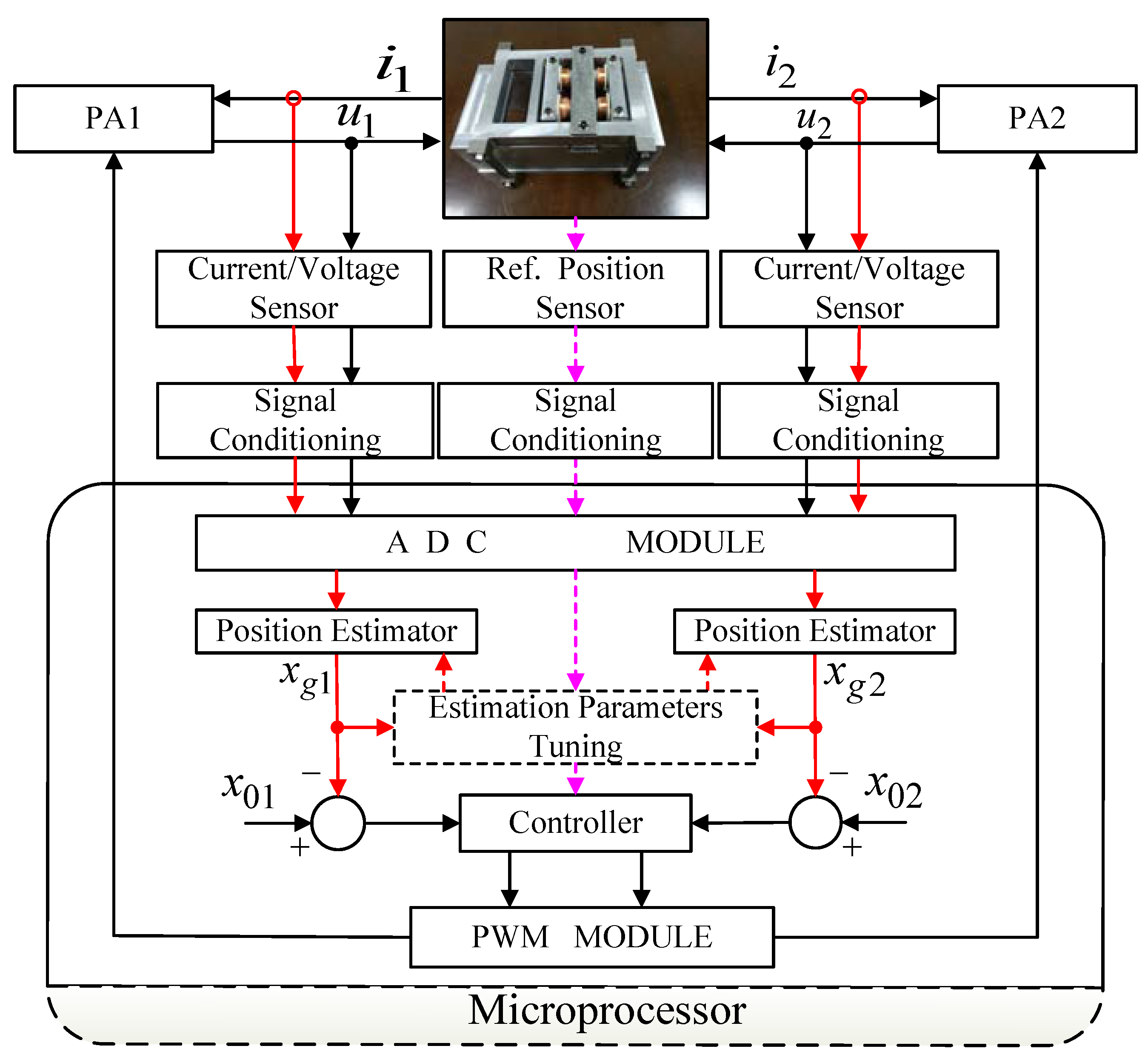

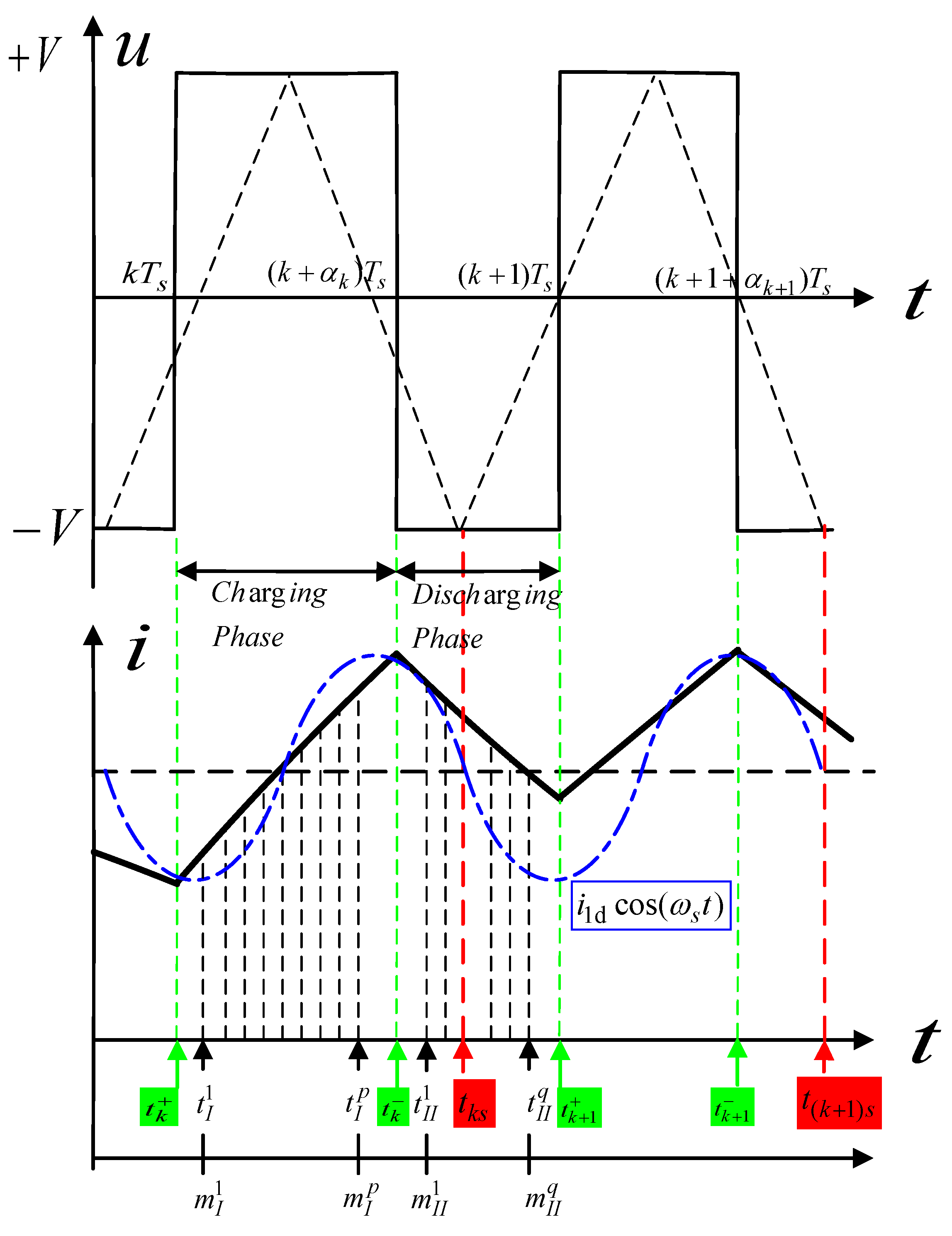
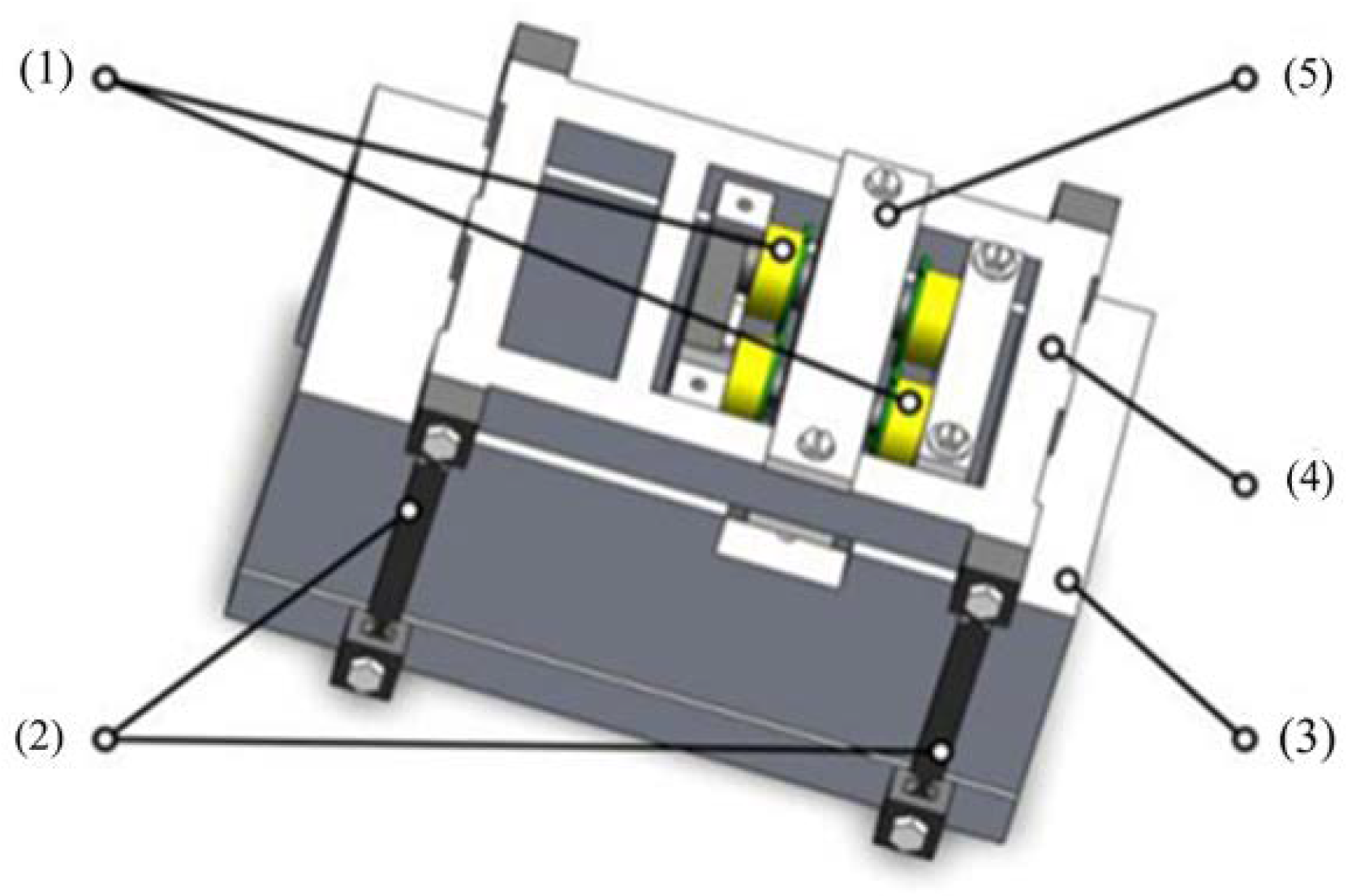
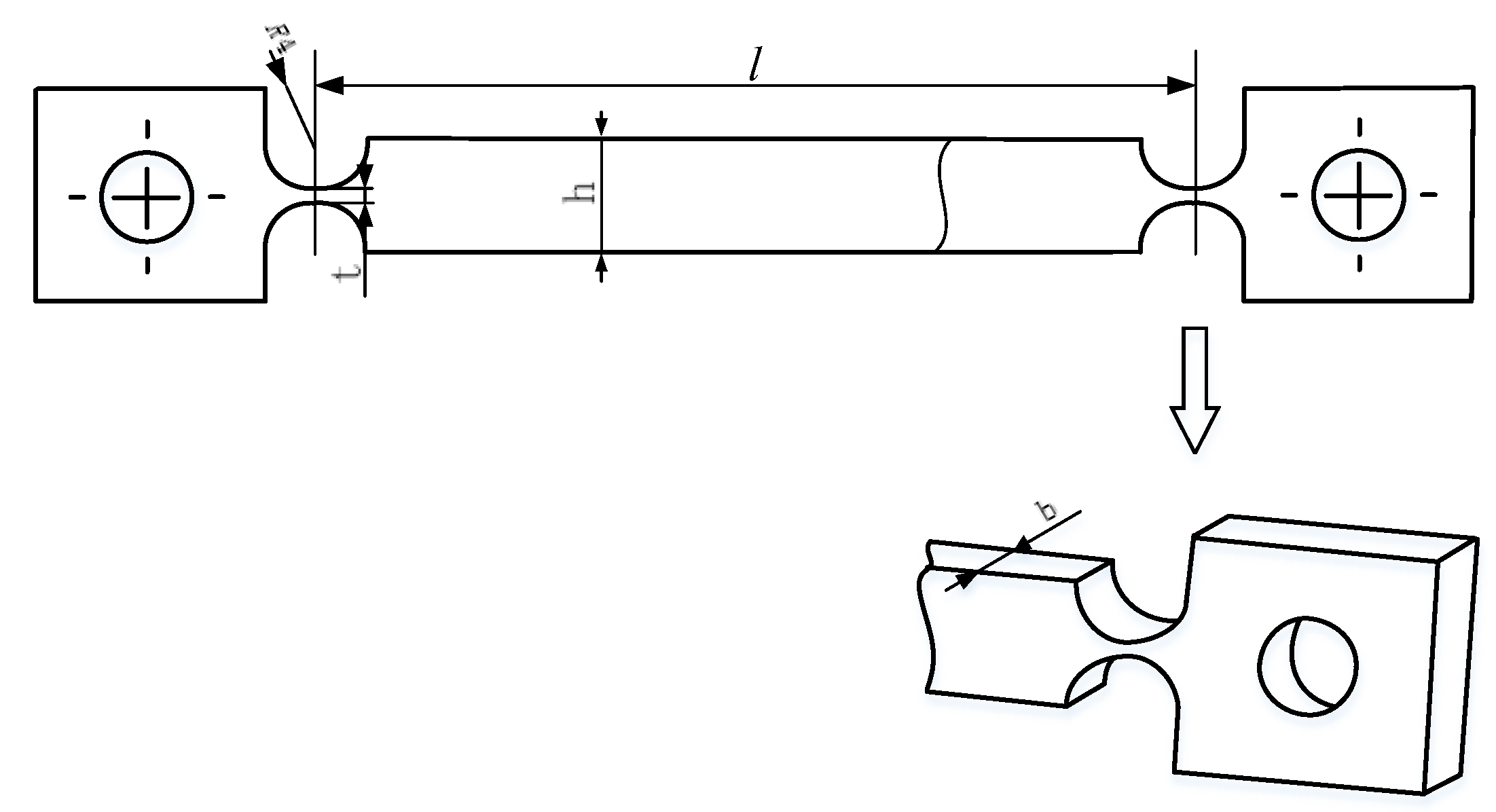
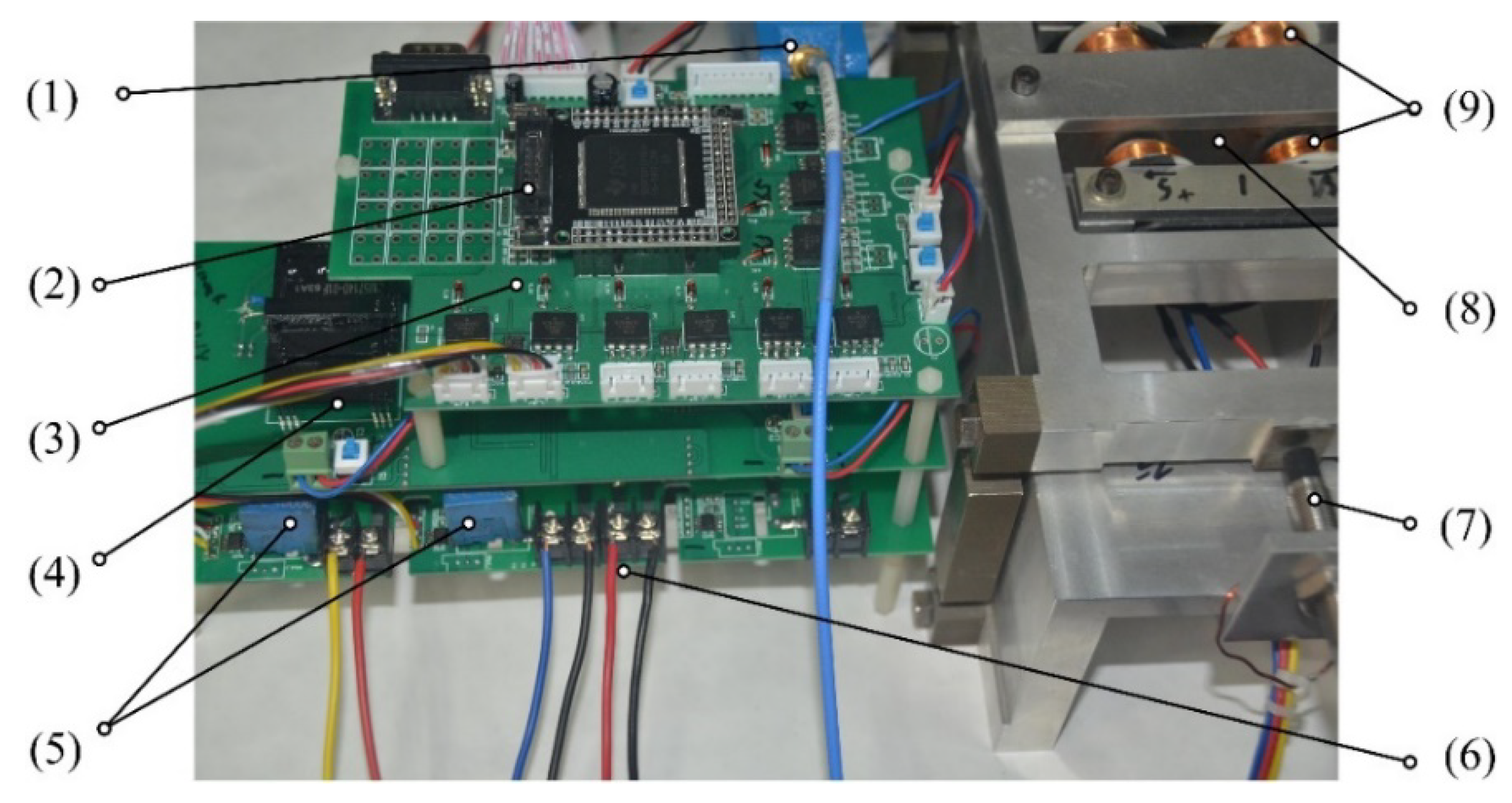
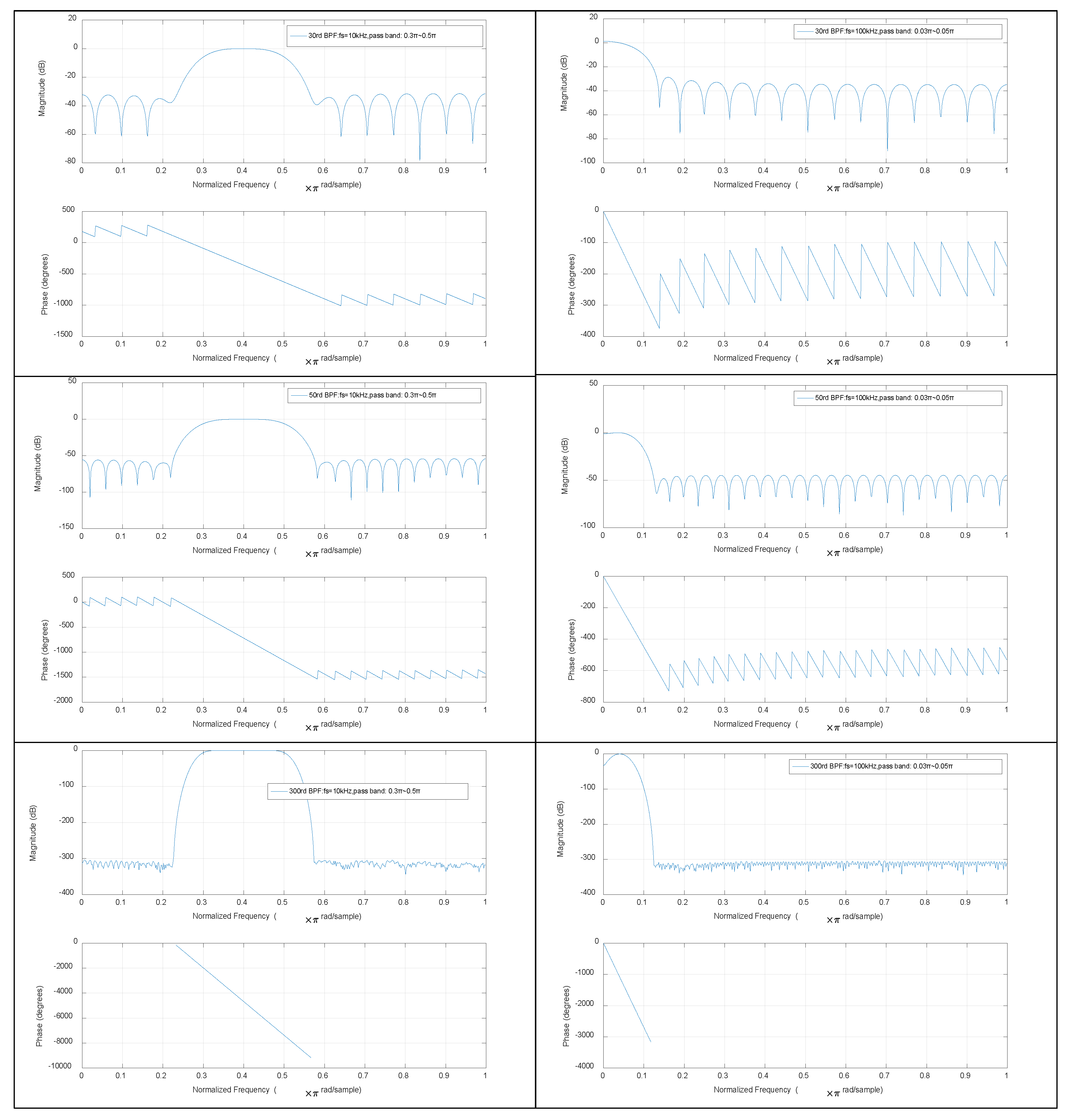
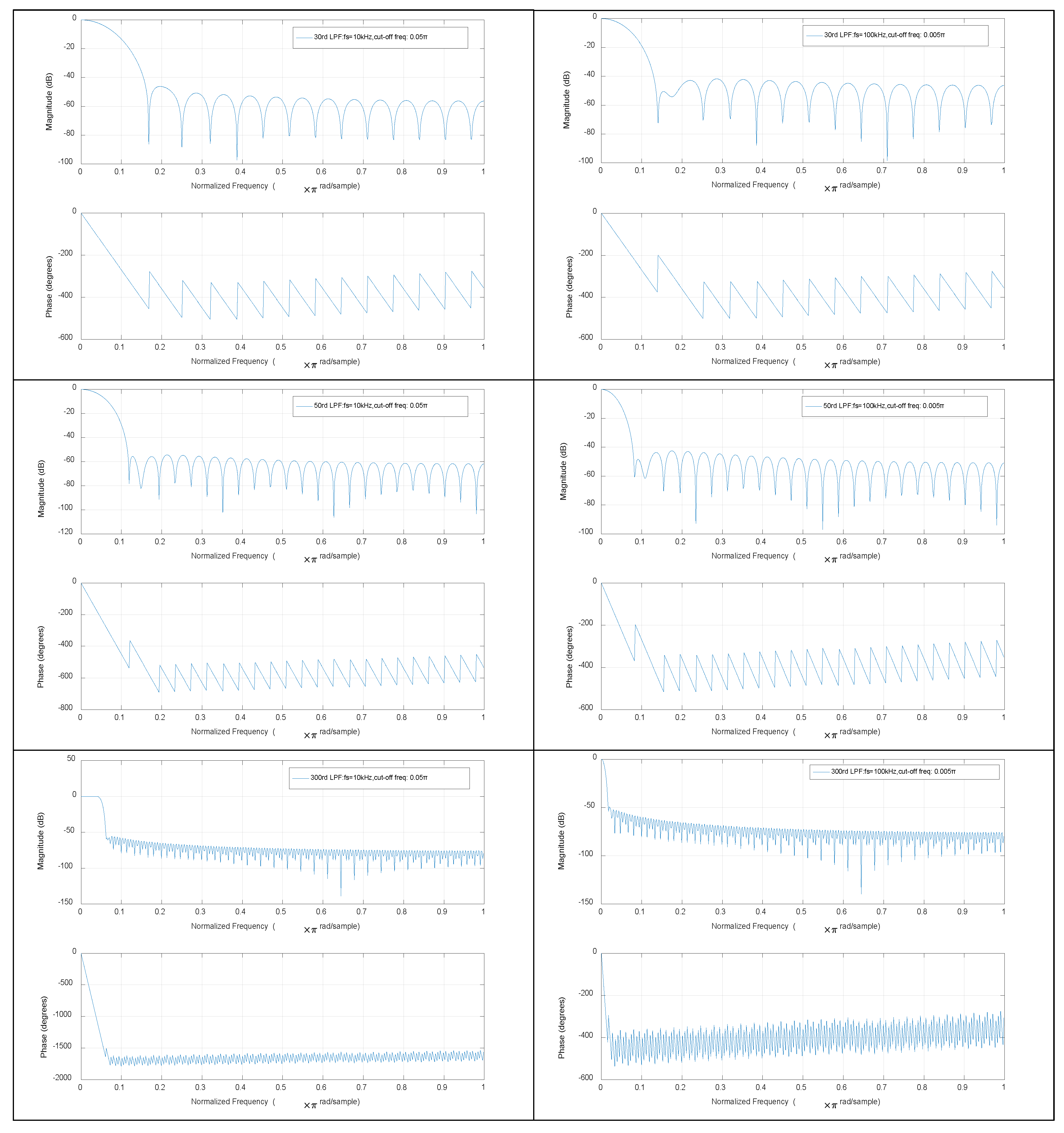

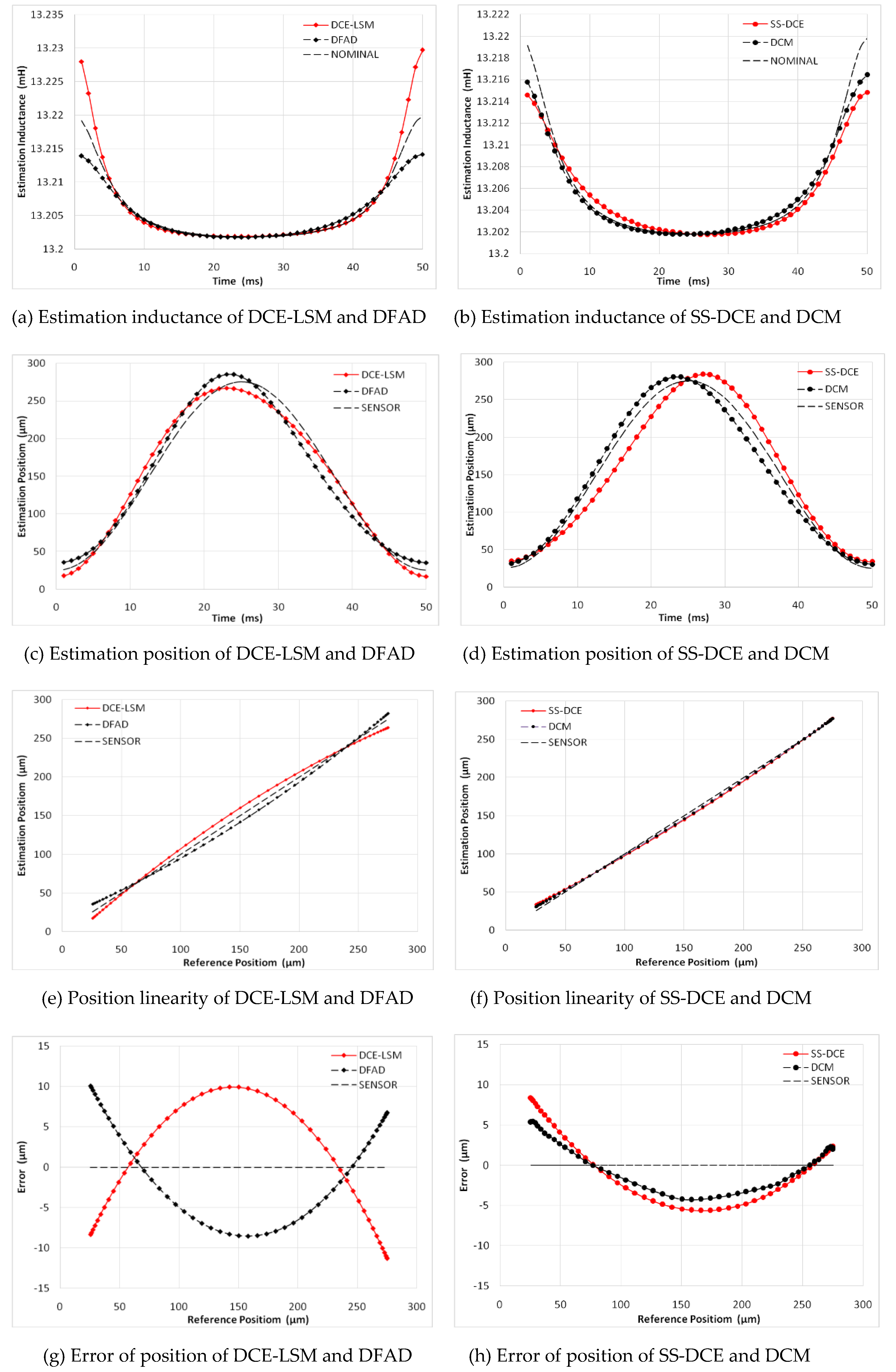
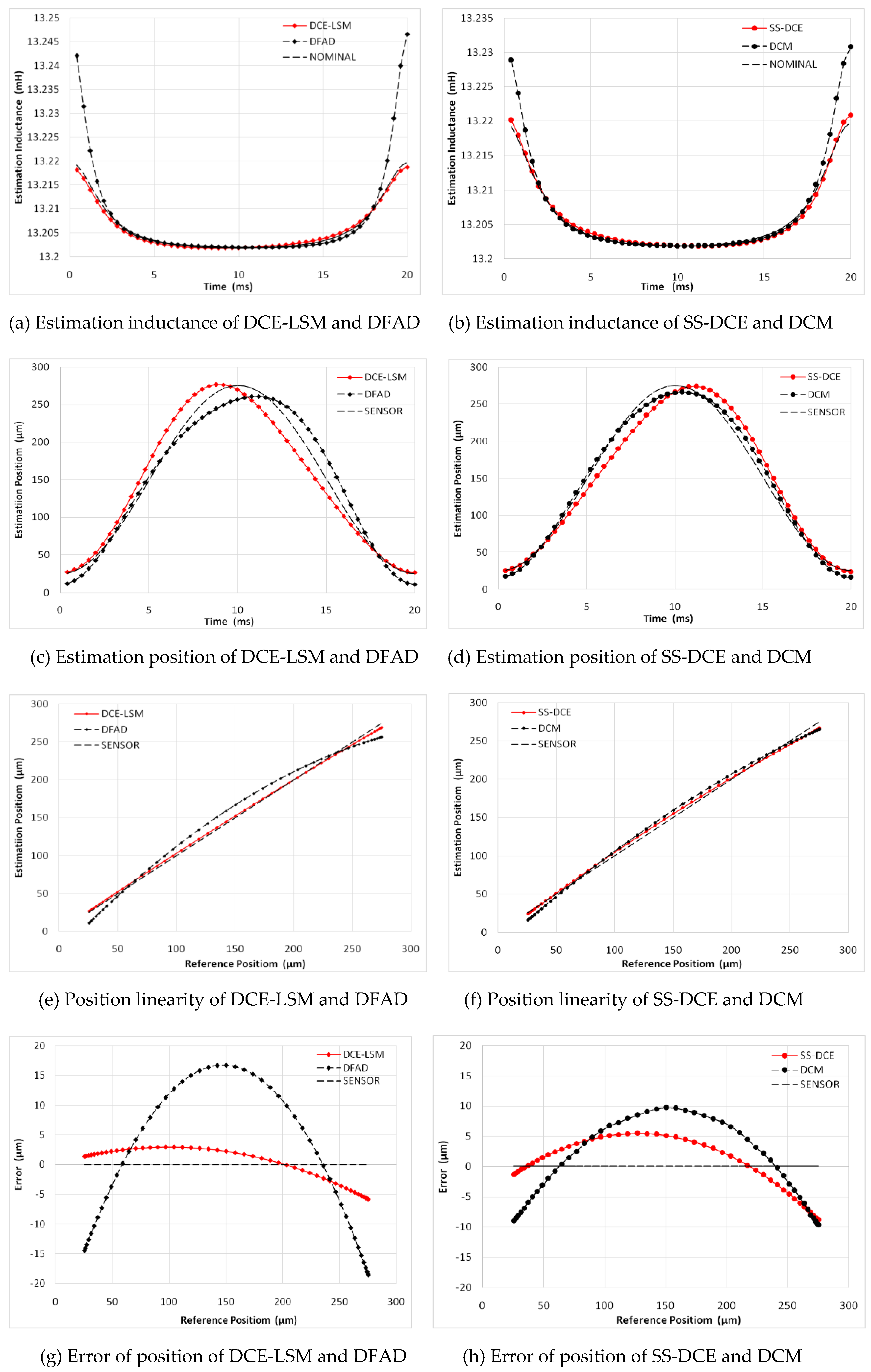
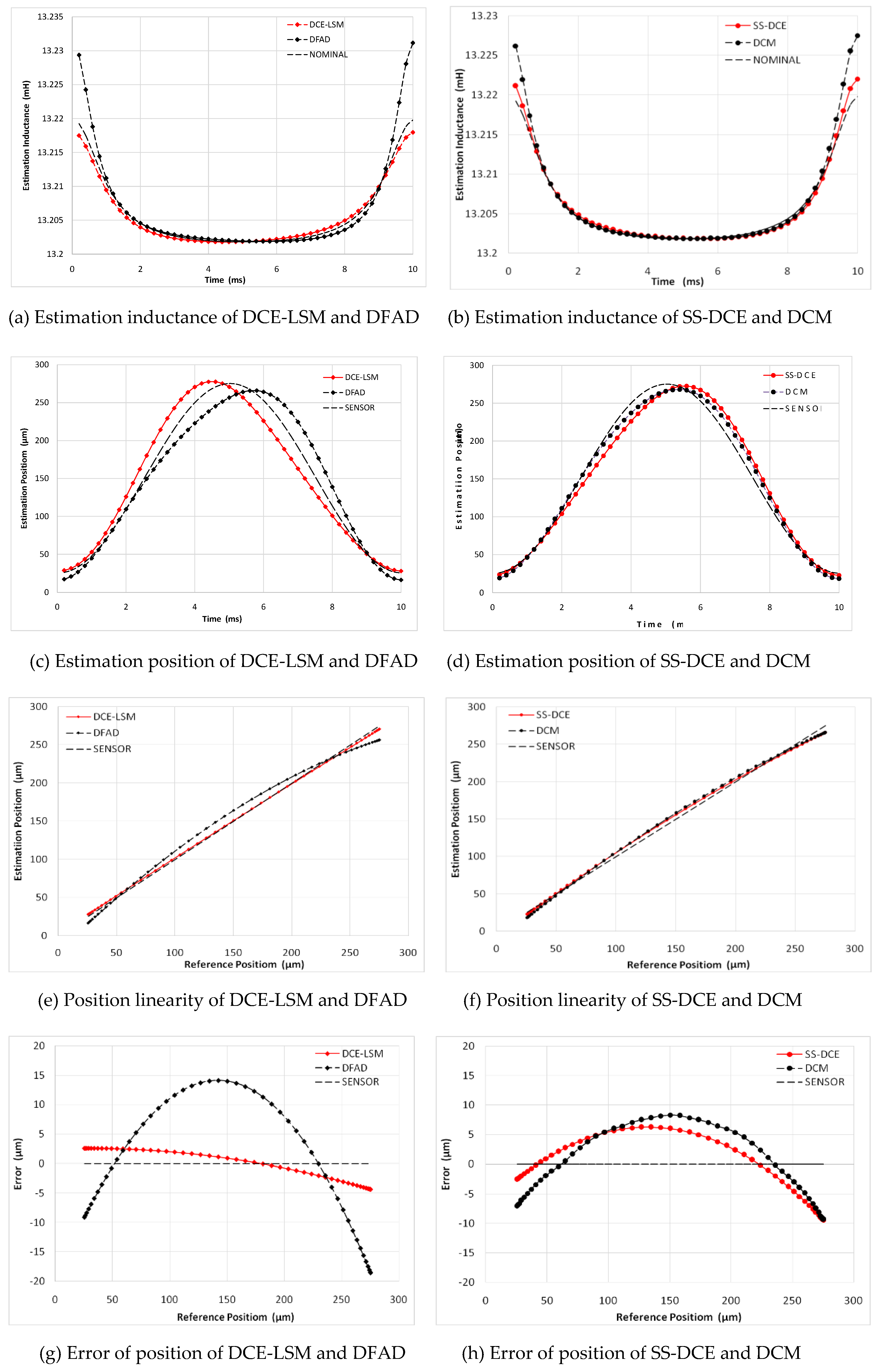
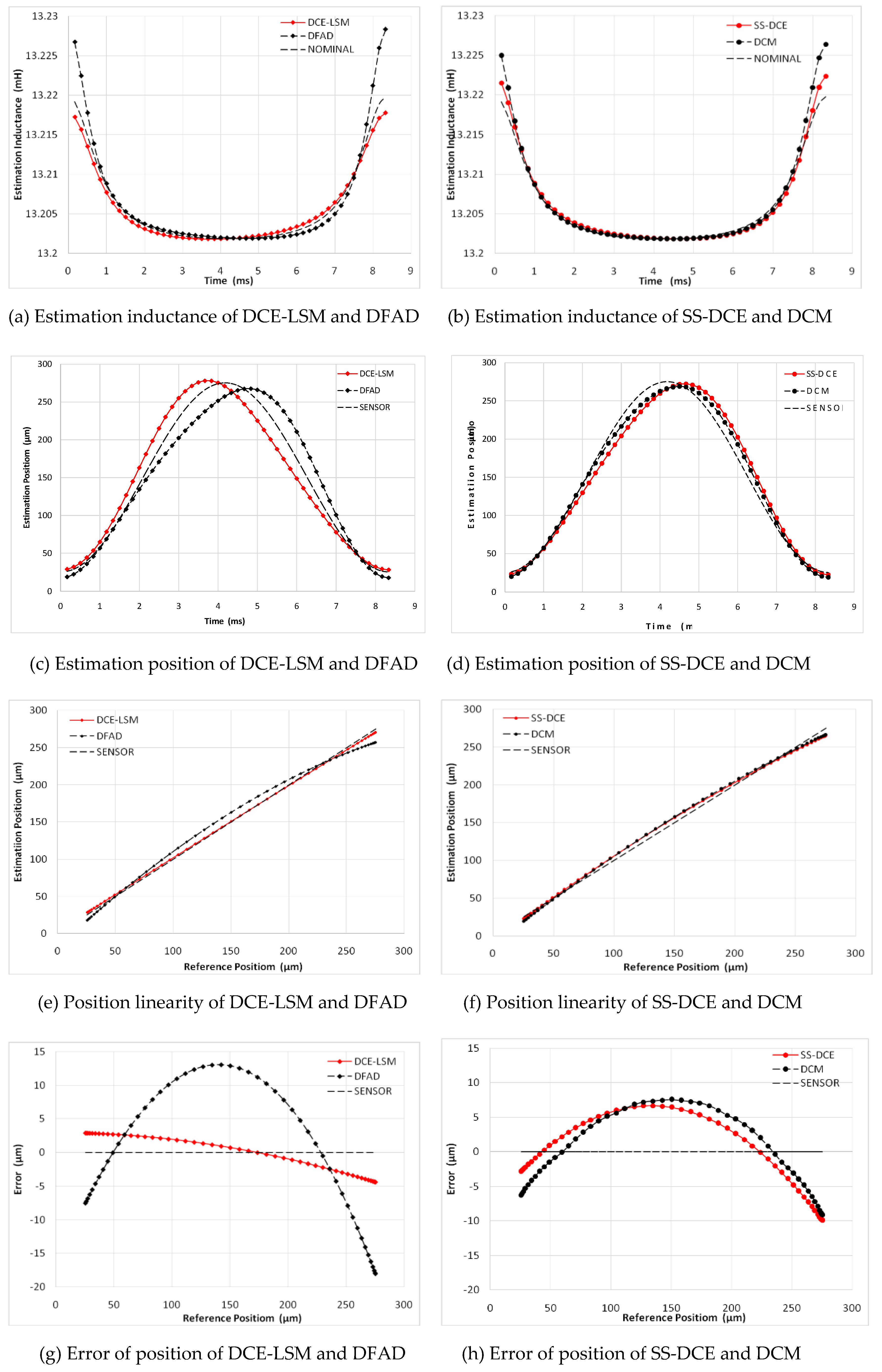
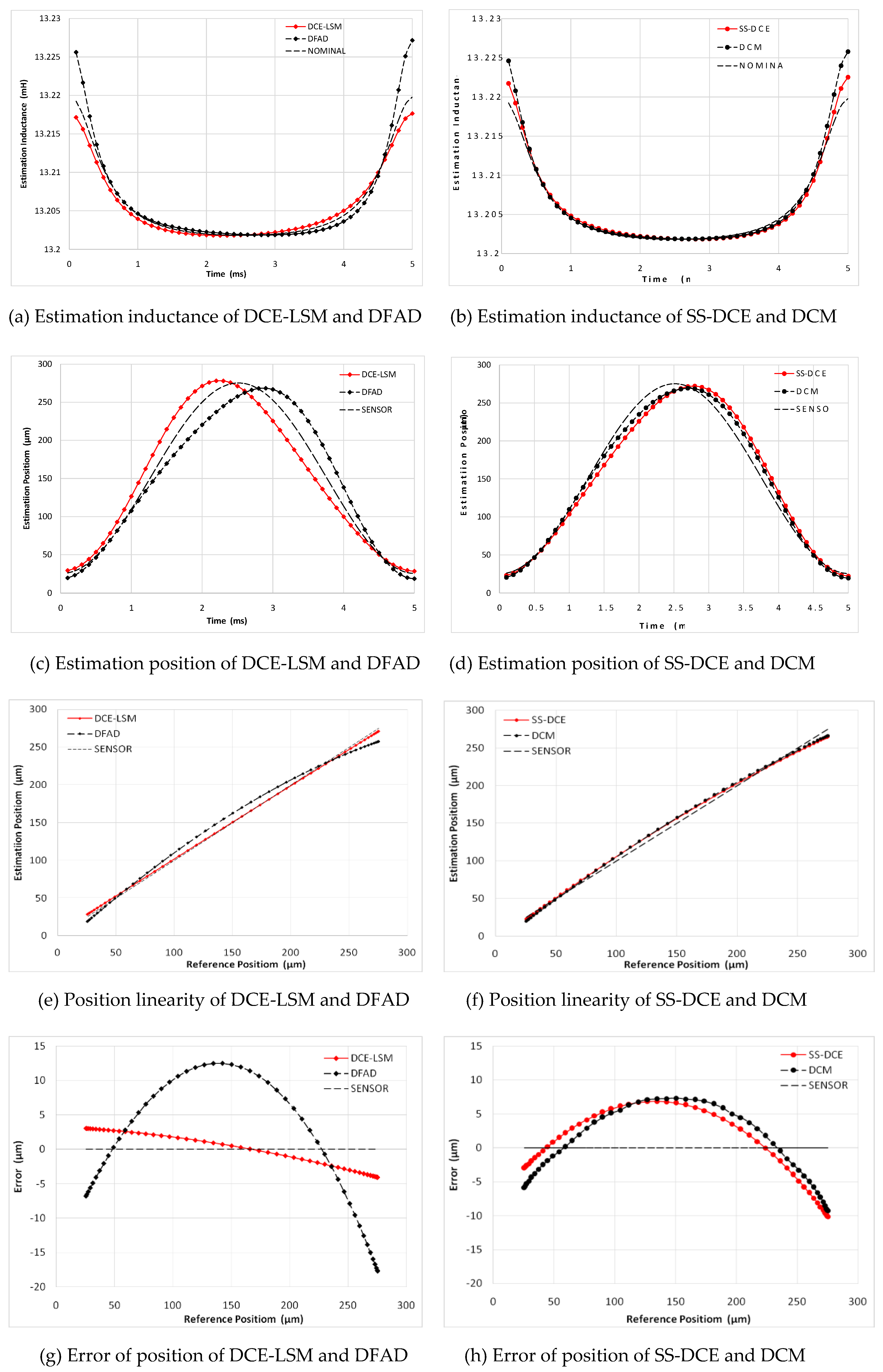
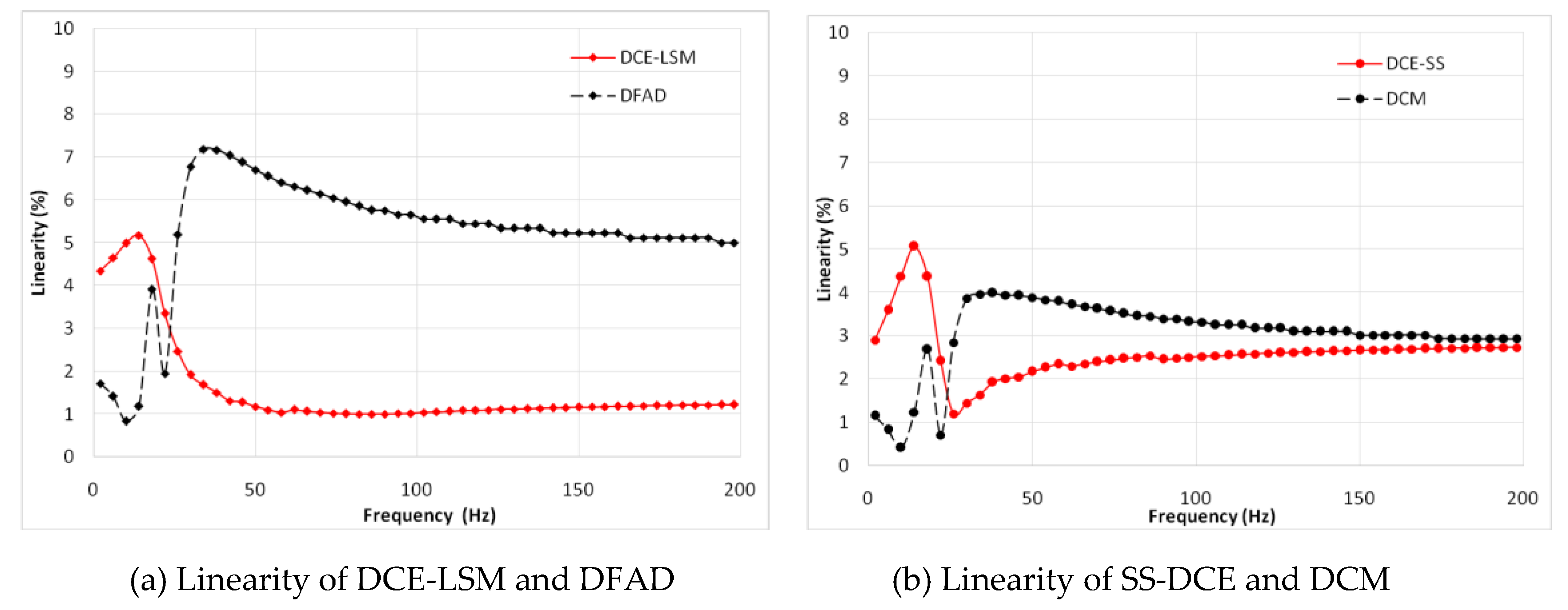
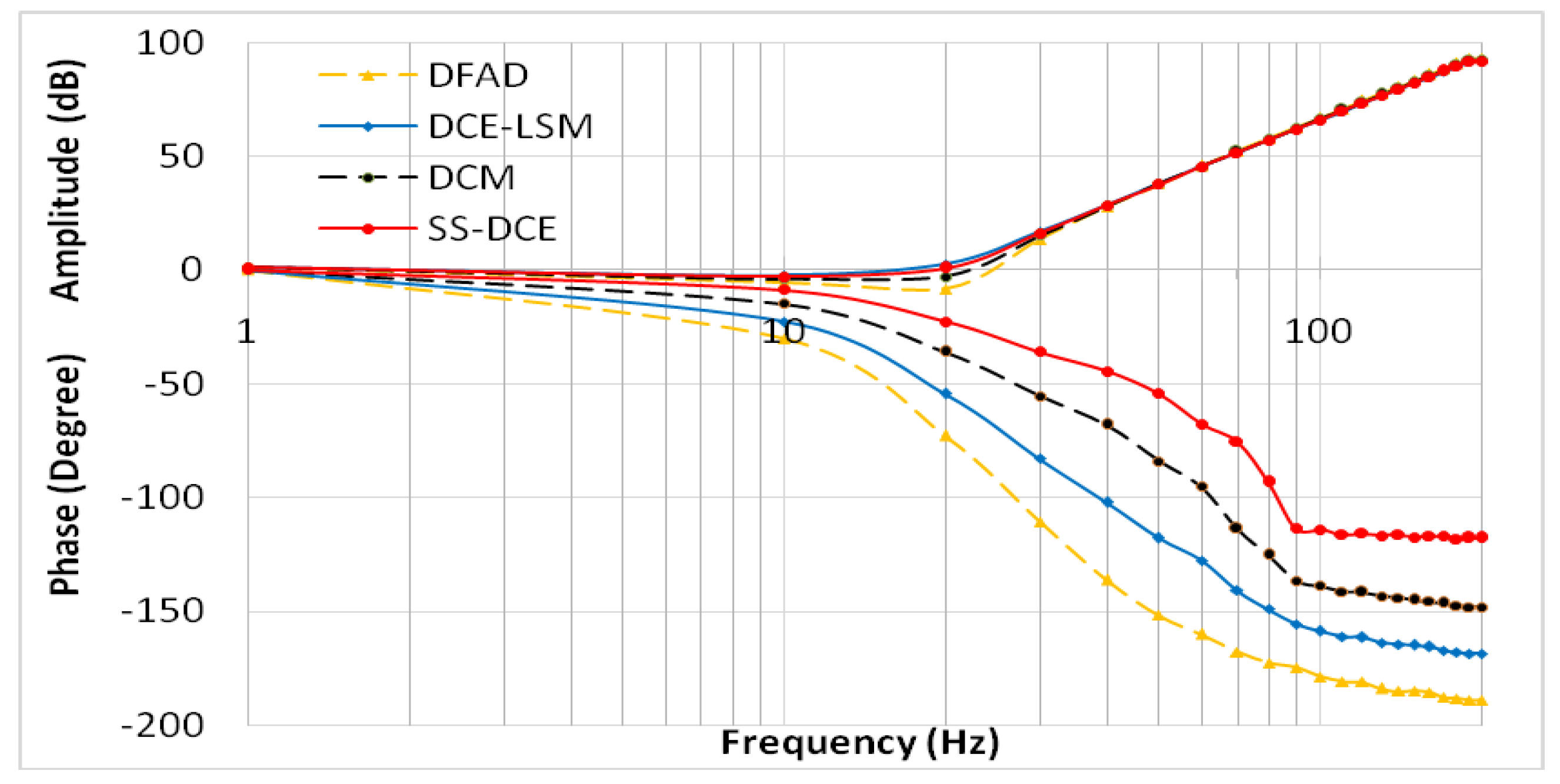
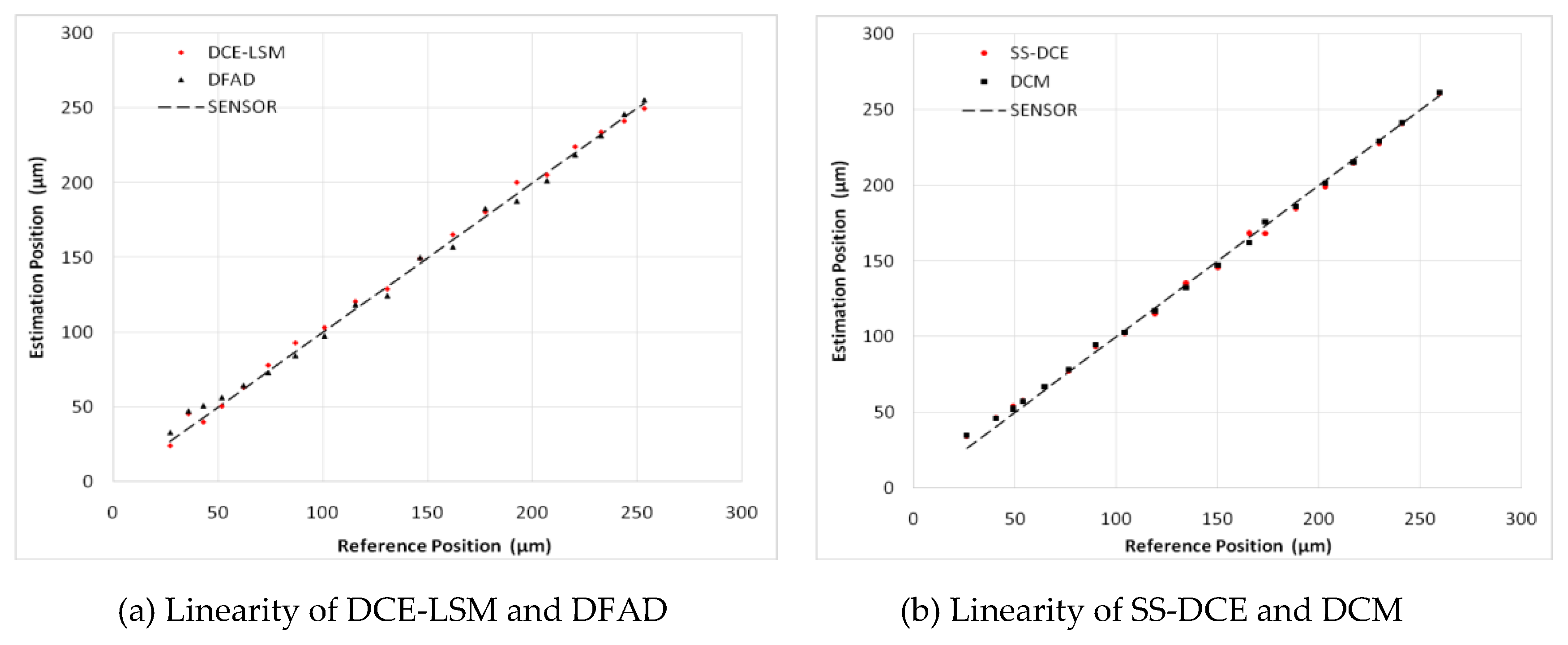
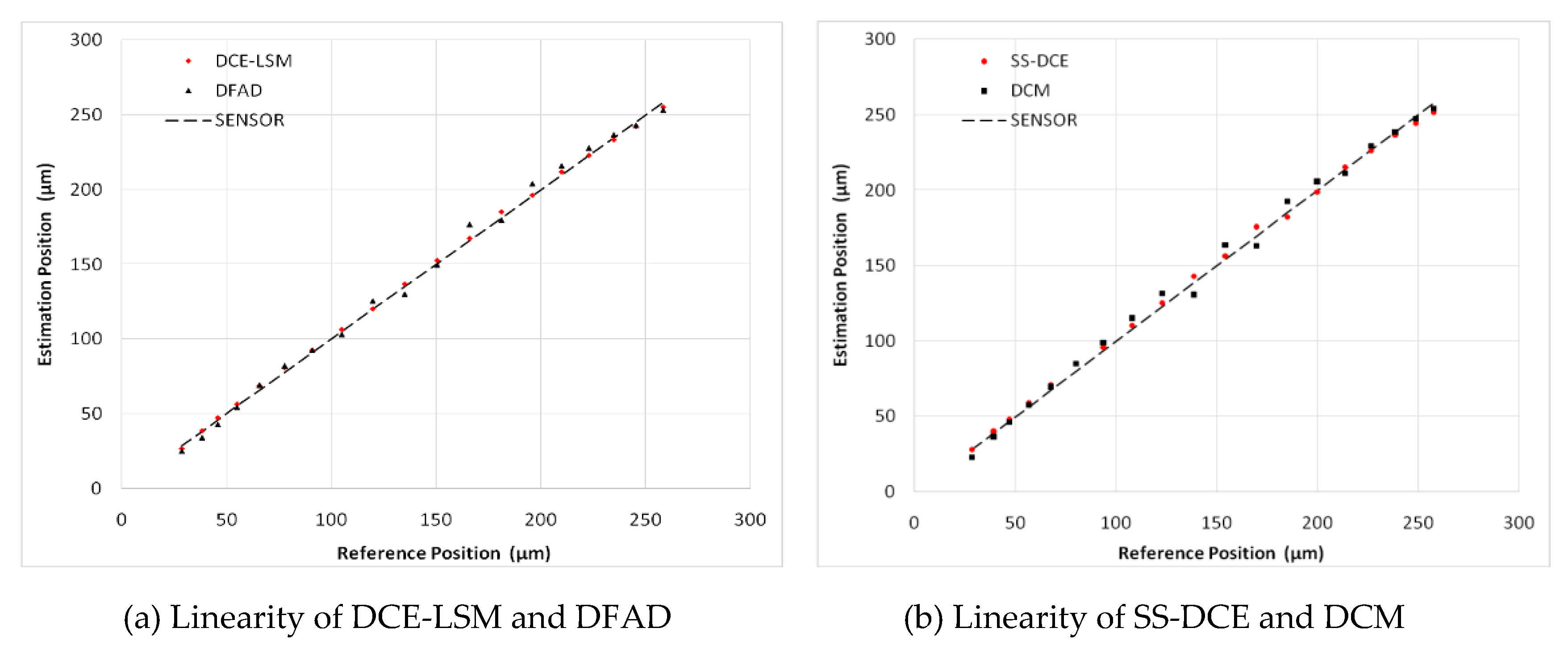

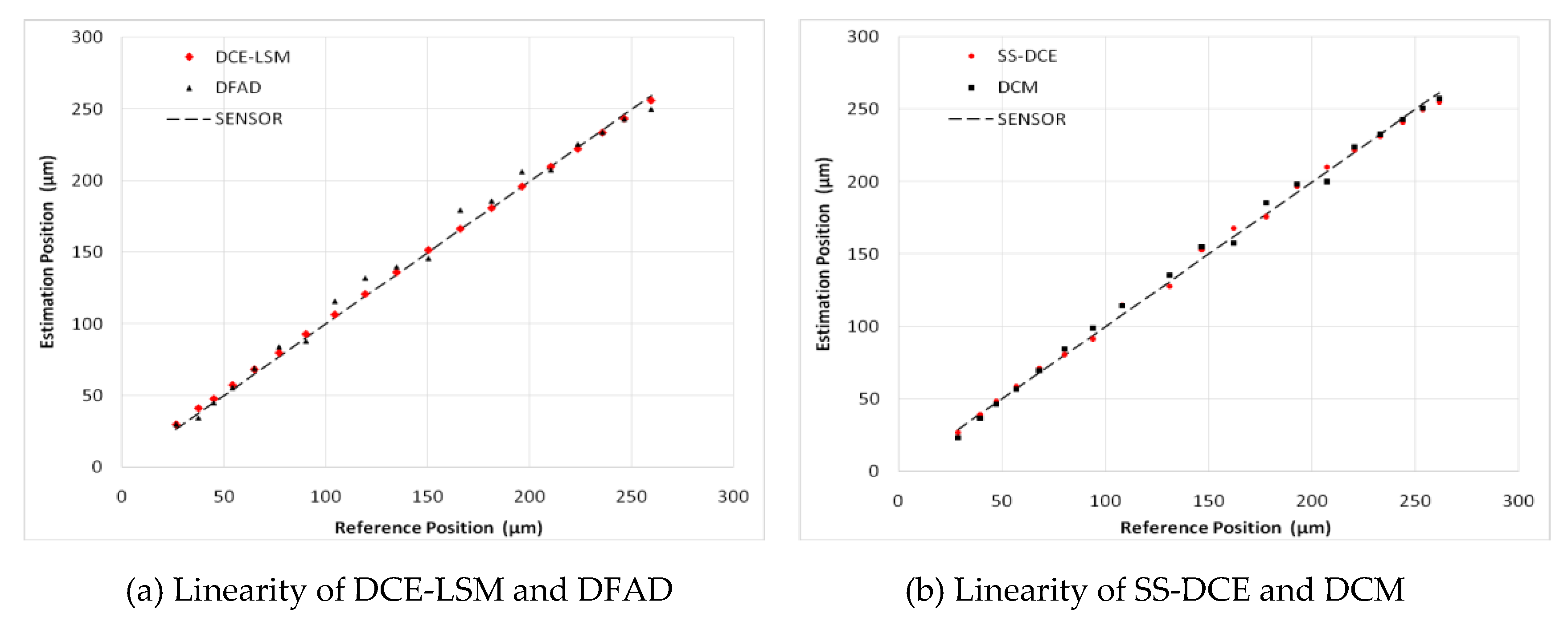
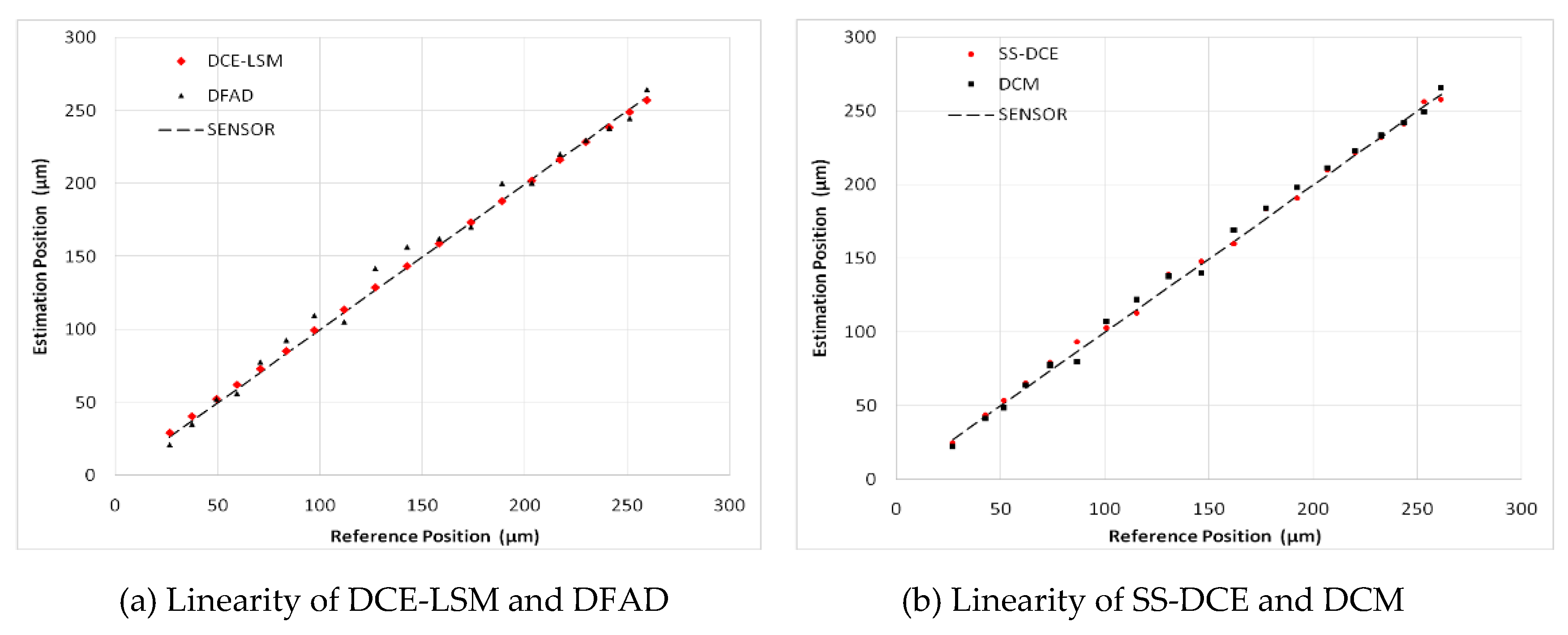

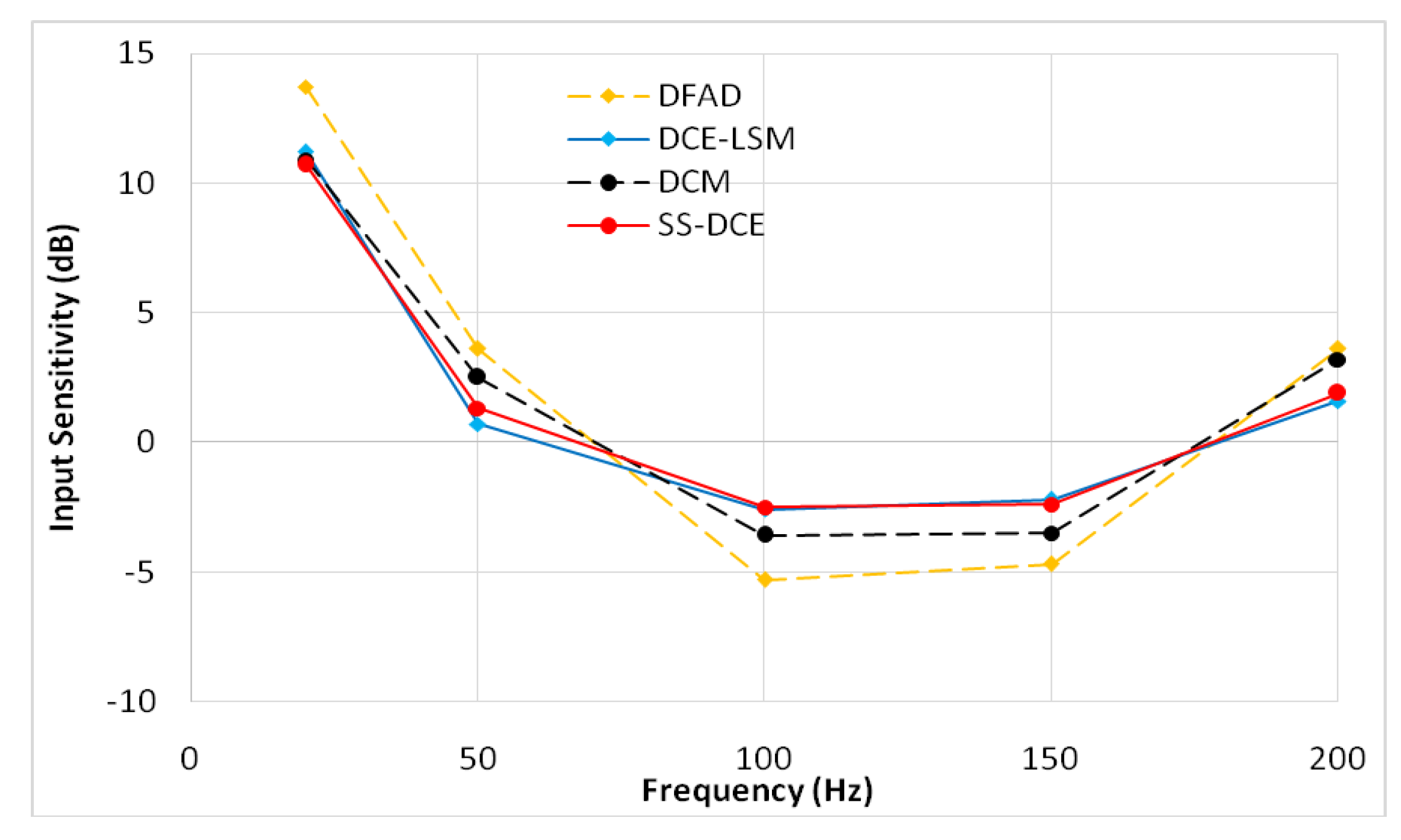
| Parameters | Values |
|---|---|
| Elastic modulus: E/Gpa | 196.2 |
| Width of flexible hinge: b/mm | 14 |
| Height of flexible hinge: h/mm | 9 |
| Minimum thickness of flexible hinge: t/mm | 1 |
| Notch radius: R/mm | 4 |
| Mechanism length: l/mm | 69 |
| Parameters | Values |
|---|---|
| Single magnetic pole area: A/cm2 | 6.16 |
| Coil number: N/turns | 50.00 |
| Initial gap: g0/μm | 6.76 × 102 |
| Rotor mass: m/kg | 1.93 |
| Relative permeability: μr | 2.30 × 103 |
| Coil resistance: R/Ω | 0.50 |
| Nominal inductance: L0/mH | 13.20 |
| PWM frequency: fs/kHz | 2.00 |
| Sampling frequency of DFAD/DCM/LSM:/kHz | 100.00 |
| Bias current: I0/A | 3.00 |
| Force/displacement factor: kx/(N/m) | −2.8 × 104 |
| Natural frequency of test rig:/Hz | 19.26 |
| Estimators | Positions (PD) | PAs (PI) | Compensators | ||||
|---|---|---|---|---|---|---|---|
| Kp (A/mm) | Kd (A·s/m) | Kp | KI | am2 | am1 | am0 | |
| DFAD | 10 | 22 | 0.2 | 0.01 | 5.51 × 105 | −1.92 × 105 | 4.10 × 106 |
| DCM | 20 | 38 | 0.5 | 0.01 | −2.50 × 105 | 1.03 × 105 | 3.78 × 106 |
| DCE-LSM | 20 | 37 | 0.5 | 0.012 | −2.50 × 105 | 1.03 × 105 | 3.78 × 106 |
| SS-DCE | 20 | 45 | 0.5 | 0.012 | −2.50 × 105 | 1.03 × 105 | 3.78 × 106 |
| Sensor | 15 | 32 | 0.2 | 0.01 | – | – | – |
| Estimator | DFAD | DCE-LSM | DCM | SS-DCE |
|---|---|---|---|---|
| Sensitivity Peak | 13.7 | 11.2 | 10.9 | 10.7 |
© 2020 by the authors. Licensee MDPI, Basel, Switzerland. This article is an open access article distributed under the terms and conditions of the Creative Commons Attribution (CC BY) license (http://creativecommons.org/licenses/by/4.0/).
Share and Cite
Hu, X.; Xu, F.; Wang, R.; Tan, D. Synchronous Sampling-Based Direct Current Estimation Method for Self-Sensing Active Magnetic Bearings. Sensors 2020, 20, 3497. https://doi.org/10.3390/s20123497
Hu X, Xu F, Wang R, Tan D. Synchronous Sampling-Based Direct Current Estimation Method for Self-Sensing Active Magnetic Bearings. Sensors. 2020; 20(12):3497. https://doi.org/10.3390/s20123497
Chicago/Turabian StyleHu, Xiongxin, Fang Xu, Ronghui Wang, and Dapeng Tan. 2020. "Synchronous Sampling-Based Direct Current Estimation Method for Self-Sensing Active Magnetic Bearings" Sensors 20, no. 12: 3497. https://doi.org/10.3390/s20123497





